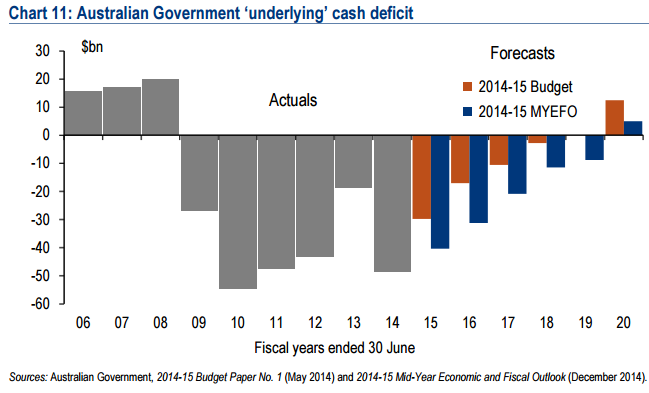Courtesy of Saul Eslake and Alex Joiner at BofAML:
In keeping with what has become the normal practice over the past decade or so, many of the decisions to be contained in next week’s Budget have been ‘preannounced’ over the past few weeks. As a result, we know that the Budget will include:
a rationalization of existing programs to assist families with child care costs, including the merger of the non-means tested Child Care Rebate with the Child Care Benefit, incorporating some redistribution of child care assistance from high-income households to lower-income households, and a tighter ‘activity test’;
a 1.5 pc point reduction in the company tax rate, and the re-introduction of accelerated depreciation for capital expenditures of up to $10,000, for ‘small businesses’ ;
allowing ‘startup’ businesses to deduct legal, accounting and othe professional costs associated with starting a business immediately (from July 2016 onwards) rather than writing them off over five years, and allowing small business owners to change the legal structure of their businesses without incurring capital gains tax;
abandoning last year’s Budget proposal to change the basis for indexing pensions from male average weekly total earnings to the (less generous) CPI, and instead lowering the upper limit on assets (in addition to a principal residence) a person of pensionable age can have before losing the entitlement to a part-pension and the Pensionsers’ Health Care Card, as well as possibly making the rate at which benefits are withdrawn as income or assets increase (the ‘taper rate’) less generous than it has been since 2007;
accelerated payments of the $10,000 subsidy to employers hiring unemployed people aged 50 and over;
a one-off $500mn payment for infrastructure programs in Western Australia to cushion the impact of sharply lower iron ore prices on that State’s budget;
changes to the Pharmaceutical Benefits Scheme, including changes to the way in which drugs are included in the PBS, to the ‘safety net’ arrangements for people who spend a large amount on prescription drugs, to payments to pharmacists, and to the way in which the scheme references generic drug prices in determining payments to pharmaceuticals producers, with a view to saving $5bn over four years;
an annual levy of 0.05% on bank deposits of up to $250,000 in order to fund a Financial Claims Scheme, raising about $500mn pa;
the establishment of a Serious Financial Crimes Task Force at a cost of $120mn over four years;
$250mn over five years to enable the Australian Bureau of Statistics to upgrade its computer systems;
an extension of the GST to ‘intangible’ services such as music and video downloads;
(possibly) a tightening of the concessional treatment of fringe benefits paid to employees of ‘public benevolent institutions’;
What won’t be in the Budget
Among the possibilities that have been canvassed but which won’t be in next week’s Budget are:
an Australian version of the ‘diverted profits tax’ introduced in this year’s UK Budget which will seek to impose a higher rate of tax on corporate profits earned from sales within the UK but declared in foreign jurisdictions for tax purposes: instead, the Budget will propose a requirement that multi-national corporations disclose hitherto confidential information about their operations in Australia and the amount of tax paid on them;
any changes to ‘negative gearing’ arrangements;
any changes to the tax treatment of superannuation contributions, earnings or payouts;
any changes to the system of ‘dividend imputation’.
What will also be missing is any credible path to surplus.


